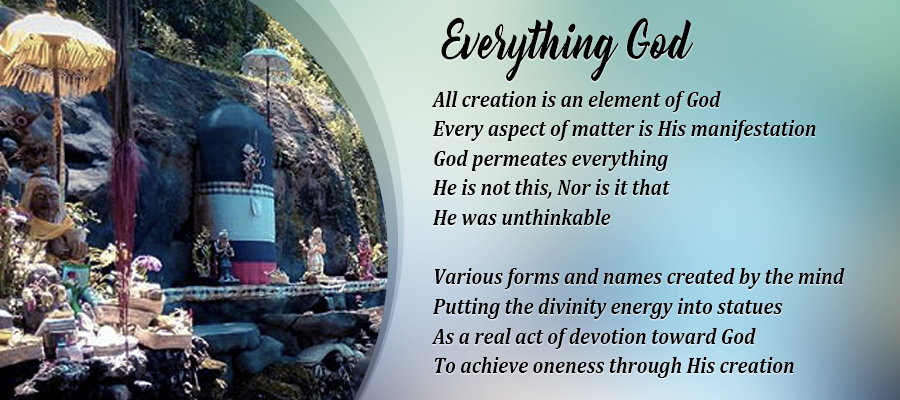- 1Acknowledging the omniscience and omnipresence of God
- 2The statues help the devotee become deeply religious
- 3As objects of concentration and meditation
- 4In worship, the true worshipper becomes unite of God
- 5The statue and Symbol help us cultivate sameness and equanimity
- 6A powerful technique to cultivate purity and relate to the deity
- 7A declaration of simple faith in the universal presence of God
- 8A Transformative and purifying practice
- 9The hidden aspect of Statue worship
- 10For balance and tolerance
Love says : I am everything. Wisdom says : I am nothing. Between the two, my life flows.
Worshiping of Statues practice shows up in the Hindu tradition as a technique described in the Upanishads as Neti Neti meaning “neither this nor that.” This approach is featured in Jnana Yoga of direct knowledge as a path to Self-realization. It is a way of using the mind to negate and disidentify with all names and forms in order to distinguish between the limited and relative world and the eternal, unchanging perfection that is the Absolute Reality. Ultimately, whatever can be conceived by the mind is not Brahman, and the practice of neti neti will eventually point to this.
An idol or an image is a living embodiment (arca) of God. It is not a lifeless form. Life is poured into a statue when it is reverentially worshipped with devotion. Devotion has such power.
With devotion, we can awaken the divine power which is hidden in any object. By overcoming the duality of the subject and the object or the knower and the known we can experience oneness with the divinity who is present in all things.
Murthi puja or image worship in Hinduism refers to the worship of the names and forms (murti) of God, any divinity or reverential people such as a guru or a saint. The practice is unique to Hinduism.
The whole creation is a form of God. Every aspect and form in it reflects his glory because God is hidden in each of them. The whole creation is sacred because it is suffused with the presence of God.
Hence, every aspect of it is worthy of worship. When you say, “God is this or that,” you are limiting him. When you say, “God should be worshipped in this or that manner only,” you are again defining and limiting your methods of worship.
Some people scoff said the idea of Hindu worship as an act of superstition. However, devout Hindus accept that worship as a simple way of expressing their faith, love, and devotion to God. There is a childlike innocence and purity of approach when a person stands reverently in front of a statue or an image and bows to it in total submission. It is possible only when a person has a strong faith and no egoism. Worldly people or intellectuals who have strong egos cannot easily surrender to God or worship his images with simple faith.
Who worship God with devotion and humility know that statue worship connects them to God and open their hearts to divine love.
A devout Hindu is not ashamed of going to a temple and bowing before an idol. He has no hesitation to stand in front of it and speak to it as if he talking to an individual with exemplary faith and devotion which is not of this world. He may be rich or poor, seeking something or simply praying without any expectation, educated or uneducated, his devotion and dedication to God and his service are unquestionable.
That way may not directly speak to God, but he knows that his prayers will surely be heard, and his devotion and love to the deity will surely be reciprocated. Even if his prayers are not answered, he continues his worship considering it a part of his karma, fate or the way God sometimes chooses to respond. Deep in his heart, he knows that he is engaged in spiritual practice, and in the end, it will only do him good and take him closer to God.
History is replete with such instances where Hindu temples were destroyed, and the Statues were subjected to desecration and senseless vandalism in the medieval times by other religion. The gods of Hinduism allowed it to happen. They remained silent and offered no help to the defenders of the faith. It does not mean the gods were helpless. They probably let it happen as part of the progression of time upon the earth.
However, amidst all this mayhem, God seemed to have opened another door for the preservation and resurgence of Hinduism. The period witnessed the rise of the devotional (Bhakti) movement and renewed interest in Statues worship. Numerous saints appeared on the scene and helped people connect to their deities through reverential prayers, ritual worship, and worship of God’s statues at homes and in the temples. The wanton violence and desecration of Hindu temples by the invaders could not shake the devotion of Hindus to their gods and goddesses and their commitment and dedication to the faith of their ancestors.
Anyone who believes that statues worship is a primitive or superstitious practice is mistaken. Hindus do not worship the statue of their gods in vain. An statue or an image of a deity is just a symbol, or a form, which serves as the object of worship or concentration and meditation and helps the devotees to connect to him. When you greet a person, you actually greet the body or the form of that person. You assume that the body is the person although the person is hidden in the body.
The same holds true in the case of statues worship. Ignorant people see the statues. The devotees see the deity. It is a matter of perspective or belief. The devotees know that the ultimate reality is beyond the senses, beyond names and forms and beyond the field of Maya or illusion. They know that although the objective reality does not truly represent God, it has its own value and importance in our understanding of truths, in our worship of God and in our experience of transcendental states.
History proves that on the path of devotion, many people in the achieved liberation through image worship. They proved that with faith and devotion one could awaken the deities that are hidden in the statues and make them respond and reciprocate to their prayers and personal requests. Their experience shows that idol worship is a powerful technique to connect to God. If there is enough devotion in the heart of a devotee, God would directly respond to those who worship his forms.





